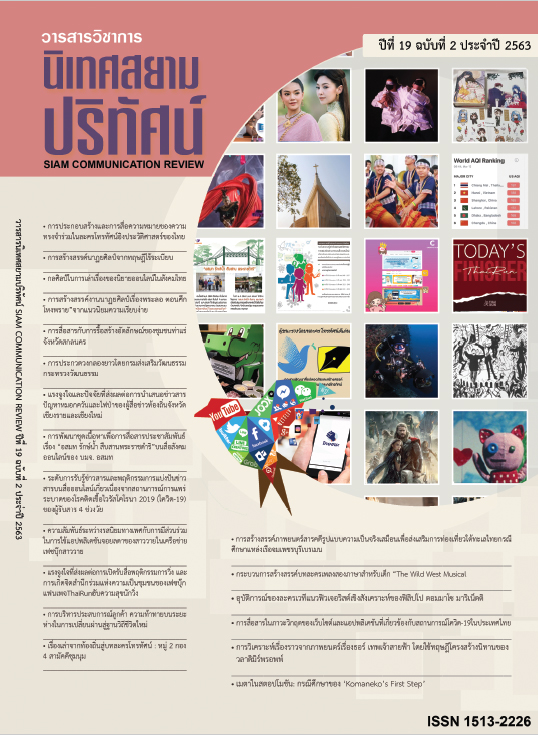The Construction and Signification of Collective Memory in Thai Historical Telenovelas
Main Article Content
Abstract
This research on the construction and signification of collective memory in Thai historical telenovelas is a study of collective memory and the construction of collective memory about the past via Thai historical Telenovelas that are based on historical events or phenomena. The research also examined the reviving of the past and the construction of new imagination through tales that are some kinds of societal representation. Based on the framework of collective memory, the research explored Thai historical Telenovelas, by in-depth interviews with 26 historical TV-drama producers and fans.
It was found that Thai Telenovelas construct and signify collective memory through a variety of narrative components: plot, theme, conflicts, characters, setting, point of view, and symbolism, with the implication of royal nationalist ideology and the perspective of the capital as a power center.
Collective memory in Thai historical Telenovelas tend to reproduce the image of the monarchy as a sacred institution which is divine, righteous and charismatic, ruling the state in peace, but collective memory overpasses local history. Accordingly, historical telenovelas play roles in emphasizing the ideology of loyalty.
Article Details
References
ภาษาไทย
ไชยันต์ รัชชกูล. (2557). ปั้นอดีตเป็นตัว. กรุงเทพฯ: อ่าน.
ถิรนันท์ อนวัชศิริวงศ์ และคณะ. (2547). สุนทรียนิเทศศาสตร์ การสื่อสารการแสดงและสื่อจินตคดี (พิมพ์ครั้งที่ 2). กรุงเทพฯ: โครงการสื่อสันติภาพ คณะนิเทศศาสตร์ จุฬาลงกรณ์มหาวิทยาลัย.
ทวีศักดิ์ เผือกสม. (2561). หยดเลือด จารึก และแท่นพิมพ์: ว่าด้วยความรู้ความจริงของชนชั้นนำสยาม พ.ศ. 2325-2411). กรุงเทพฯ : Illuminations Editions.
ธงชัย วินิจจะกูล. (2544). ประวัติศาสตร์ไทยแบบราชาชาตินิยม จากยุคอาณานิคมอำพรางสู่ราชาชาตินิยมใหญ่ หรือลัทธิเสด็จพ่อของกระฎุมพีไทยในปัจจุบัน. ศิลปวัฒนธรรม, 23(1), 56-65.
. (2562). ออกนอกขนบประวัติศาสตร์: ว่าด้วยประวัติศาสตร์นอกขนบและวิธีวิทยาทางเลือก. นนทบุรี: ฟ้าเดียวกัน.
นัทธนัย ประสานนาม. (2561). “วรรณกรรมกับประวัติศาสตร์” ในประเทศไทยจากมุมมองความทรงจำศึกษา. วารสารอักษรศาสตร์ มหาวิทยาลัยศิลปากร, 40(1), 51-84.
นิธิ เอียวศรีวงศ์. (2538). กรุงแตก, พระเจ้าตากฯ และประวัติศาสตร์ไทย: ว่าด้วยประวัติศาสตร์และ ประวัติศาสตร์นิพนธ์. กรุงเทพฯ: มติชน.
. (2538). ชาติไทย, เมืองไทย, แบบเรียน และอนุสาวรีย์: ว่าด้วยวัฒนธรรม, รัฐ และรูปการจิตสำนึก. กรุงเทพฯ: มติชน.
. (2545). ว่าด้วยการเมืองของประวัติศาสตร์และความทรงจำ. กรุงเทพฯ: มติชน.
. (2557). ชาติไทย,เมืองไทย,แบบเรียนและอนุสาวรีย์ ว่าด้วยวัฒนธรรม, รัฐ และรูปการจิตสำนึก. กรุงเทพฯ: มติชน.
ปฐมพงษ์ สุขเล็ก. (2560). การเมือง เรื่องเล่า พระเจ้าตาก หลัง 2475. กรุงเทพ: มติชน.
ประจักษ์ ก้องกีรติ. (2558). การเมืองวัฒนธรรมไทย: ว่าด้วยความทรงจำ/วาทกรรม/อำนาจ. นนทบุรี: ฟ้าเดียวกัน.
. (2558). การเมืองวัฒนธรรมไทย: ว่าด้วยความทรงจำ/วาทกรรม/อำนาจ. นนทบุรี : ฟ้า เดียวกัน.
ศรัณยู หมั้นทรัพย์. (2559). ความทรงจำร่วมของการต่อสู้ของประชาชน: มองผ่าน “รูปหล่อ” แกนนำกลุ่มรักษ์ท้องถิ่นบ่อนอกและเครือข่ายประชาชนภาคตะวันออก. รายงานการประชุม การประชุมทางวิชาการระดับชาติ โดยเครือข่ายประวัติศาสตร์มานุษยวิทยาและสังคมวิทยาภาคใต้ ครั้งที่ 2 เรื่อง “ศาสตร์แห่งการจำและศิลป์แห่งการลืม” วันที่ 25-27 สิงหาคม 2559 ณ มหาวิทยาลัยสงขลานครินทร์ วิทยาเขตปัตตานี (หน้า 62-64). ปัตตานี: มหาวิทยาลัยสงขลานครินทร์.
สรณัฐ ไตรลังคะ. (2560). ศาสตร์และศิลป์แห่งการเล่าเรื่อง (พิมพ์ครั้งที่ 3). กรุงเทพฯ: โครงการเผยแพร่ผลงานทางวิชาการ คณะมนุษยศาสตร์ มหาวิทยาลัยเกษตรศาสตร์.
สรรัตน์ จิรบวรวิสุทธิ์. (2554). พัฒนาการและสุนทรียทัศน์ในการสร้างสรรค์บทละครในโทรทัศน์ไทย. วิทยานิพนธ์มหาบัณฑิต คณะนิเทศศาสตร์, จุฬาลงกรณ์มหาวิทยาลัย.
สายชล สัตยานุรักษ์. (2545). ความเปลี่ยนแปลงในการสร้างชาติไทยและความเป็นไทยโดยหลวงวิจิตรวาทการ. กรุงเทพฯ: มติชน.
สุเนตร ชุตินธรานนท์ และคณะ. (2557). ชาตินิยมในแบบเรียนไทย. กรุงเทพฯ: มติชน.
ภาษาอังกฤษ
Assmann, J. (2008). Communicative and Cultural Memory. In a. Erll & A. Nunning (Eds.), A Companion to Cultural Memory Studies (pp. 109-118). Berlin: Walter de Gruyter.
Assmann, J., & Czaplicka, J. (1995). Collective memory and Cultural identity. New German Critique, (65), 125-133.
Erll, A., & Nunning, A. (Ed.) (2008). Cultural Memory Studies: An International and Interdisciplinary Handbook. Berlin: De Gruyter.
Erll, A. (2011). Memory in Culture. (Sara B.Young, Trans). London: Palgrave Macmillan.
Halbwachs, M. (1992). On Collective Memory. (Lewis A. Coser, Trans). Chicago: University of Chicago Press.
. (1980). The Collective Memory. New York: Harper & Row.
Legoff, J. (1992). History and Memory. (Steven Rendall and Elizabeth Claman, Trans). New York: Columbia University Press.
ออนไลน์
อรรถจักร สัตยานุรักษ์. (2560, 21 เมษายน). การต่อสู้บนพื้นที่ ‘ความทรงจำ’. กรุงเทพธุรกิจ. เข้าถึงได้จาก http://www.bangkokbiznews.com/blog/detail/641003


